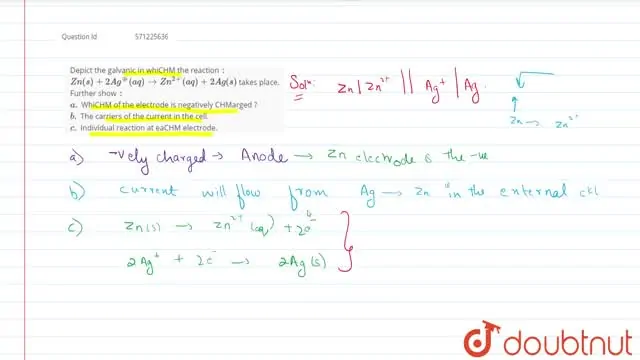Depict the galvanic in whiCHM the reaction :
Zn(s)+2Ag⊕(aq)→Zn2+(aq)+2Ag(s) takes place.
Further show :
a. WhiCHM of the electrode is negatively CHMarged ?
b. The carriers of the current in the cell.
c. Individual reaction at eaCHM electrode.
The galvanic cell corresponding to the given redox reaction can be represented as :
Zn∣∣Zn2+(aq)∣∣∣∣Ag+(aq)∣∣Ag
(i) Zn electrodes is negatively charged because at this electrode , Zn oxidizes to Zn2+ and the leaving electrons accumulate on this electrode .
(ii) Ions are the carriers of current in the cell.
(iii) The reaction taking place at Zn electrode can be represented as :
Zn(s)→Zn2+(aq)+2e−
And the reaction taking place at Zn electrode can be represented as :
Ag2+(aq)+e−→Ag(s)
(iv) In aqueous solutions, CuCl2 ionizes to give Cu2+ and Cl− ions as :
CuCl2(aq)→Cu2+(aq)+2Cl−(aq)
On electrolysis , either of Cu2+ ions or H2O molecules can get reduced at the cathode . But the reduction potential of Cu2+ is more than that of H2O molecules .
Cu2+(aq)+2e−→Cu(aq),E∘=+0.34V
H2O(l)+2e−→H2(g)+2OH−,E∘=−0.83V
Hence , Cu2+ ions are reduced at the cathode and get deposited .
Similarly , at the anode , either of Cl− or H2Ois oxidized . The oxidation potential of H2O is higher than that of Cl− .
2Cl(aq)→Cl2(g)+2e−,E∘=−1.36V
2H2O(l)→O2(g)+4H+(aq)+4e−,E∘=−1.23V
But oxidation of H2O molecules occurs at a lower electrode potential than that of Cl− ions because of over -voltage (extra voltage required to liberate gas ) . As a result , Cl− ions are oxidized at the anode to liberate Cl2 gas .
Related Playlists
- BOOK - NCERT ENGLISHCHAPTER - REDOX REACTIONSEXERCISE - EXERCISE30videos
REDOX REACTIONS
- BOOK - NCERT ENGLISHCHAPTER - ORGANIC CHEMISTRY- SOME BASIC PRINCIPLES AND TECHNIQUESEXERCISE - EXERCISE40videos
ORGANIC CHEMISTRY- SOME BASIC PRINCIPLES AND TECHNIQUES
- BOOK - NCERT ENGLISHCHAPTER - SOME BASIC CONCEPTS OF CHEMISTRY EXERCISE - All Questions45videos
SOME BASIC CONCEPTS OF CHEMISTRY
Similar Questions
Depict the galvanic cell in which the reaction :
Zn(s)+2Ag⊕(aq)→Zn2+(aq)+2Ag(s) takes place.
Further show :
a. Which of the electrode is negatively charged ?
b. The carriers of the current in the cell.
c. Individual reaction at each electrode.View SolutionDepict the galvanic cell in which the cell reaction is
Cu+2Ag+→2Ag+Cu2+View SolutionThe equivalent constant of the reaction:
Cu(s)+2Ag+(aq.)→Cu2+(aq.)+2Ag(s)
E∘=0.46V at 298K,is:View SolutionWhat is the limitation of the reaction given
Zn(s)+2HCl(aq)→ZnCl2(aq)+H2↑⏐View SolutionThe equilibrium constant of the reaction :
Zn(s)+2Ag+(aq)→Zn(aq)+2Ag(s),E∘=1.50V at
298 K isView SolutionThe cell reaction Zn(s)+Cu+2→Zn+2+Cu(s) is best represented as :
View SolutionZn(s)+Cu2+(aq)→Zn2+(aq)+Cu(s) The cell representation for the above redox reaction is
View SolutionFor the reaction,
Zn(s)+2HCl(aq)→ZnCl2(aq)+H2(g),ΔH is equal to ΔE.View SolutionWrite short hand notation for the following reaction Sn2+(aq)+2Ag+(aq)→Sn4+(aq)+2Ag(s).
View SolutionCalculate the equilibrium constant of the reaction :
Cu(s)+2Ag(aq)⇔Cu2+(aq)+2Ag(s)
Ec−.cell=0.46VView Solution


